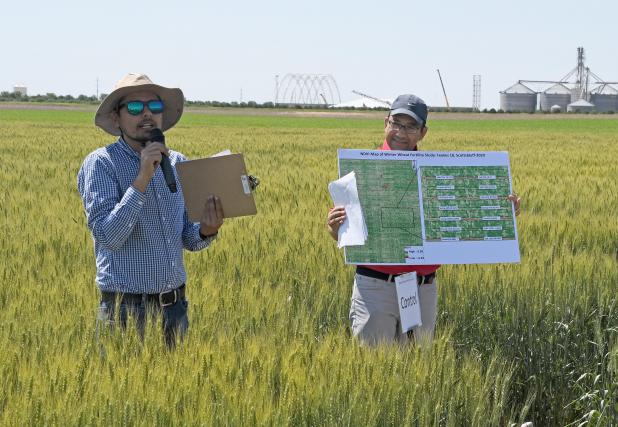
Researcher Dipak Santra, left, explains some of the data shown on the map they collect with aerial and handheld sensors on their wheat plots.
Wheat fertility trial in third year
Wheat researchers from the University of Nebraska look forward to reaping more data from fertility and variety trials underway at the Henry J. Stumpf International Wheat Center just east of Grant.
The center held its annual field day tour June 14. They followed up Wednesday with pea research plots at the Steve Tucker farm west of Brandon.
This marks the third year of an ongoing study to measure the effectiveness of nitrogen application on wheat.
Researcher Dipak Santra said they have 200 different plots at the center with varying rates of nitrogen with varying times of application.
Santra said they use just one variety of wheat, Ruth, to eliminate variables that could occur with different varieties.
He explained they apply different rates of nitrogen based off the university’s recommended rate for wheat. These varying rates includes 25%, 50%, 75%, 100% 125%.
They also change the time of application with some plots fertilized in the fall, some in the spring and some in both seasons.
In the first two years, they only applied ammonium nitrate.
This year they added nitrogen in the form of urea, another dry source of nitrogen.
He said they used urea with an inhibitor and a polymer-coated urea. Both are designed as a slow-release formulation to make nitrogen available for a longer period of time.
Santra said weather the first two years of the study proved to be complete opposites.
In 2018-19, the center got lots of moisture and they had plot yields of 100 bushels per acre.
In 2019-20, dry conditions prevailed, which had a definite affect on yields. Some plots showed no intake of nitrogen due to the conditions.
He said they are anxious to see how the yields look this year based on how good the wheat is looking thus far.
Drone, handheld sensors
Santra said they collect data on nitrogen intake using spectral light and drought stress via infrared cameras.
They have a large drone equipped with a number of sensors that they fly over the plot several times per year.
They also use handheld spectral light monitors over each row of wheat in the 200 plots.
The center has been without an extension agent/researcher since the departure of Strahinja Stepanovic.
Mike Boehm, vice chancellor for the Institute of Agriculture and Natural Resources, was at the Stumpf field day and said they have just posted the opening.
COVID-19 and a $10 million budget cut for IANR delayed the hiring process for the position. He said there goal is to fill the position in the coming months.
One position that became a priority to fill was that of wheat breeder Stephen Baenziger who has served as the lead wheat, barley and triticale breeder for about 35 years.
That position is now held by Nebraska native Katherine Frels. She grew up in the Hershey area and studied under Baenziger and spent the last five years at the University of Minnesota.
Boehm said she will be a real asset to the wheat research program at the university.
Frels also reviewed the 50+ varieties growing in plots at the center as part of the university’s annual wheat variety yield trials.
There are 18 different test plots across the state that will be harvested within the next month.
Initial data on the yield studies will be available online in time for farmers to make planting decisions for next years crop of hard red winter wheat.
New equipment building
University officials noted a large equipment building will be built at the Stumpf center.
This building will house all farm machinery and equipment that has been stored in a large shop area attached to the center.
This will allow the center to use that area for educational and training space.
Pulse crop trials
University researchers and seed representatives conducted a tour on the variety trials at the Steve Tucker farm.
Peas can be an alternative crop in a dryland rotation.
The primary varieties of peas grown is Nebraska are yellow peas.
Tuckers trials included some green peas varieties. The biggest challenge with green peas is marketing.
India was a big consumer of green peas but has been out of the market.
